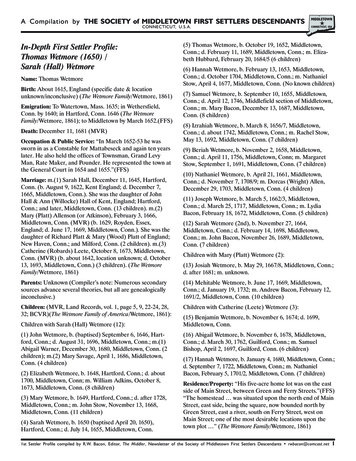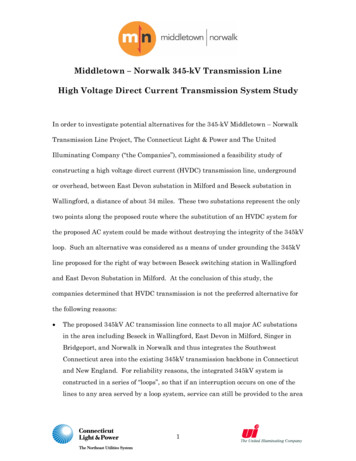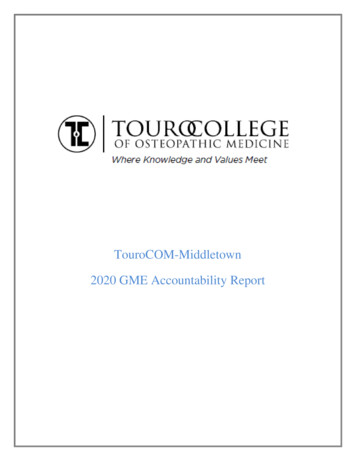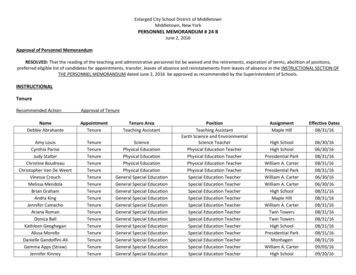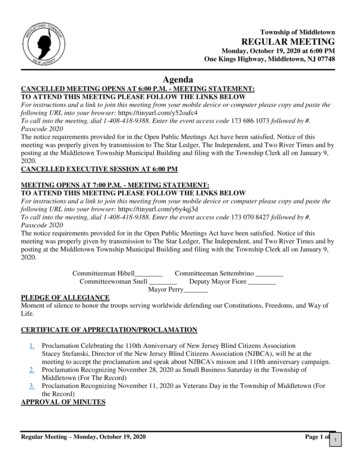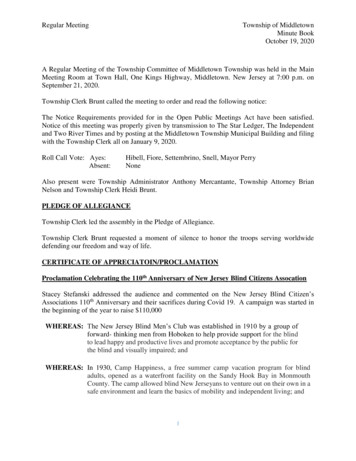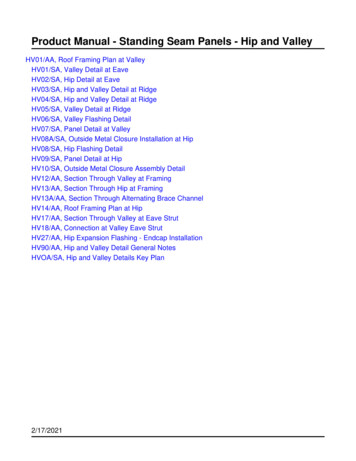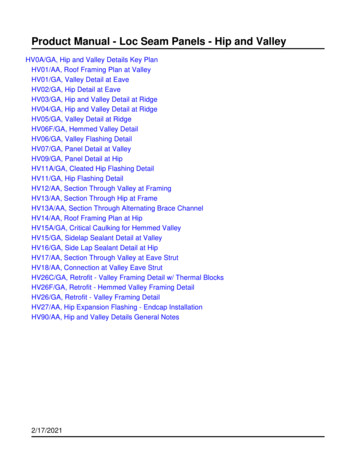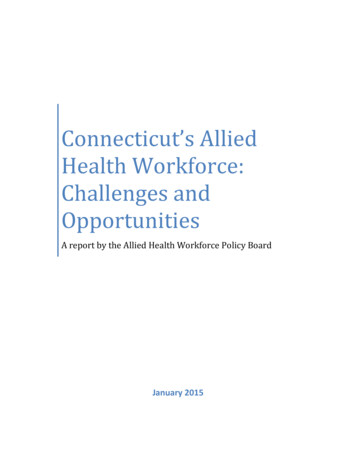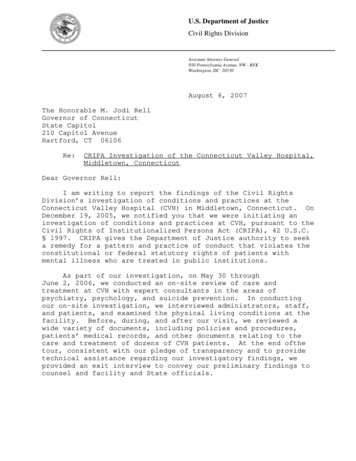
Transcription
U.S. Department of JusticeCivil Rights DivisionAssistant Attorney General950 Pennsylvania Avenue, NW - RFKWashington, DC 20530August 6, 2007The Honorable M. Jodi RellGovernor of ConnecticutState Capitol210 Capitol AvenueHartford, CT 06106Re:CRIPA Investigation of the Connecticut Valley Hospital,Middletown, ConnecticutDear Governor Rell:I am writing to report the findings of the Civil RightsDivision’s investigation of conditions and practices at theConnecticut Valley Hospital (CVH) in Middletown, Connecticut. OnDecember 19, 2005, we notified you that we were initiating aninvestigation of conditions and practices at CVH, pursuant to theCivil Rights of Institutionalized Persons Act (CRIPA), 42 U.S.C.§ 1997. CRIPA gives the Department of Justice authority to seeka remedy for a pattern and practice of conduct that violates theconstitutional or federal statutory rights of patients withmental illness who are treated in public institutions.As part of our investigation, on May 30 throughJune 2, 2006, we conducted an on-site review of care andtreatment at CVH with expert consultants in the areas ofpsychiatry, psychology, and suicide prevention. In conductingour on-site investigation, we interviewed administrators, staff,and patients, and examined the physical living conditions at thefacility. Before, during, and after our visit, we reviewed awide variety of documents, including policies and procedures,patients’ medical records, and other documents relating to thecare and treatment of dozens of CVH patients. At the end ofthetour, consistent with our pledge of transparency and to providetechnical assistance regarding our investigatory findings, weprovided an exit interview to convey our preliminary findings tocounsel and facility and State officials.
- 2As a threshold matter, we wish to express our appreciationto the staff of CVH and to State officials for their extensiveassistance and cooperation during our investigation. We hope tocontinue to work with CVH and the State of Connecticut in thesame cooperative manner in addressing the problems that we found.Further, we wish to particularly thank those individual CVH staffmembers, both new and longstanding, who make daily efforts toprovide appropriate care and treatment and improve the lives ofpatients at the hospital. Those efforts were noted andappreciated by us and our expert consultants.Consistent with our statutory obligations under CRIPA, I nowwrite to advise you formally of the findings of ourinvestigation, the facts supporting them, and the minimalremedial steps that are necessary to remedy the deficiencies setforth below. 42 U.S.C. § 1997b(a). Specifically, we haveconcluded that numerous conditions and practices at CVHviolate the constitutional and federal statutory rights of itsresidents. In particular, we find that CVH fails to provideits patients adequate: 1) protection from harm; 2) psychiatricand psychological care and treatment; and 3) discharge planningand placement in the most integrated setting. See Youngberg v.Romeo, 457 U.S. 307 (1982); Title XIX of the Social Security Act,42 U.S.C. § 1396; 42 C.F.R. Part 483, Subpart I (Medicaid ProgramProvisions); Americans with Disabilities Act (ADA), 42 U.S.C.§ 12132 et seq.; 28 C.F.R. § 35.130(d); see also Olmstead v.L.C., 527 U.S. 581 (1999).I.BACKGROUNDThe General Hospital for Insane of the State of Connecticutopened in 1868 in Middletown, Connecticut. By 1900, the hospitalhoused approximately 2,000 patients. In 1953, the State’s newDepartment of Mental Health took over administration of thehospital. The facility was renamed Connecticut Valley Hospitalin 1961. In the mid-1990s, the State closed two other Statehospitals, Fairfield Hills Hospital and Norwich Hospital, andconsolidated those programs at CVH.CVH is currently a 549-bed psychiatric hospital located on apleasant campus of approximately 100 acres. CVH is the largestof five public in-patient treatment facilities operated by theConnecticut Department of Mental Health and Addiction Services(DMHAS). CVH provides in-patient treatment and care forindividuals 18 years and older, from throughout the State, withacute psychiatric, geriatric, forensic, and addiction serviceneeds. There are three main divisions at CVH: the WhitingForensic Division, the General Psychiatry Division, and the
- 3Addiction Services Division. Approximately half of the CVHpatients are in the Whiting Forensic Division, which specializesin services for involuntarily committed individuals involved withthe criminal justice system and includes the State’s onlymaximum-security psychiatric units. There are five mainresidential complexes at CVH: Whiting Forensic Institute(maximum and moderate security forensic units), Battell Hall(general psychiatry and traumatic brain injury units), WoodwardHall (geriatric units), Dutcher Service (forensic community reentry program), and Merritt Hall (addiction services and generalpsychiatry units).II.FINDINGSPatients of state-operated facilities have a right to livein reasonable safety and to receive adequate health care, alongwith habilitation to ensure their safety and freedom fromunreasonable restraint, prevent regression, and facilitate theirability to exercise their liberty interests. See Youngberg v.Romeo, 457 U.S. 307 (1982); Kurlak v. City of New York, 88 F.3d63, 75 (2d Cir. 1996) (applying the Youngberg standard totreatment given in a mental health hospital). If a patient isadmitted to a psychiatric hospital for care and treatment, theState has a duty to treat the patient. Woe v. Cuomo, 729 F.2d96, 105 (2d Cir. 1984) (holding that if justification forcommitment of psychiatric patients rests, even in part, upon theneed for care and treatment, then a State that commits must alsotreat). In the Second Circuit, for the purposes of a patients’constitutional liberty interests, no distinction exists betweenvoluntarily and involuntarily committed patients. Society forGood Will to Retarded Children, Inc. v. Cuomo, 737 F.2d 1239,1243 (2d Cir. 1984) (“We need not decide whether . . . residentsare [committed] ‘voluntarily’ or ‘involuntarily’ because ineither case they are entitled to safe conditions and freedom fromundue restraint.”). Determining whether treatment is adequatefocuses on whether institutional conditions substantially departfrom generally accepted professional judgment, practices, orstandards. Youngberg, 457 U.S. at 353. The State is alsoobliged to provide services in the most integrated settingappropriate to the individual patient’s needs. Title II of theAmericans with Disabilities Act (ADA), 42 U.S.C. § 12132 et seq.;28 C.F.R. § 35.130(d); see Olmstead v. L.C., 527 U.S. 581 (1999).As described in greater detail below, we find that certainconditions and services at CVH substantially depart fromgenerally accepted standards, and violate the constitutional andfederal statutory rights of patients. In particular, we findthat CVH fails to: (1) adequately protect patients from harm and
- 4undue restraints; (2) provide adequate psychiatric andpsychological services; and (3) ensure adequate dischargeplanning and placement in the most integrated setting appropriateto each patient’s individualized needs.A.PROTECTION FROM HARMPatients’ constitutional liberty interests compel states toprovide reasonable protection from harm. Youngberg, 457 U.S. at315-16; Good Will, 737 F.2d at 1243 (patients of mental healthinstitutions have a right to safe conditions). In order toprotect patients from harm, hospitals have a duty to adequatelysupervise patients known to be suicidal. Dinnerstein v. U.S.,486 F.2d 34 (2d Cir. 1973) (veterans hospital held liable for notadequately supervising patient with history of known suicidaltendencies).In our judgment, CVH fails to provide its patients with areasonably safe living environment. The facility too oftensubjects its patients to harm or risk of harm. CVH fails toprotect its patients from harm due to inadequate suicide policiesand practices; overuse of unnecessary seclusion and restraint; aninadequate risk management system that fails to collect,organize, and track incidents of harm and abuse for the purposeof identifying and preventing potential incidents of harm andabuse; and a lack of an adequate quality assurance systemnecessary to ensure quality of care across all aspects of careand treatment.Unfortunately, CVH has a history of failing to protect itspatients from harm. In a 15-month period in 2003 and 2004, threepatients at CVH committed suicide by hanging. In each case, itappeared that staff were aware of the suicide risk, but failed totake appropriate action. One suicide occurred nine hours after anurse identified that the patient had thoughts of suicide, butthen failed to assess him for suicide risk or take properprecautions. In the wake of these suicides, CVH has promulgatednew policies and procedures. In spite of these remedial efforts,however, training and practices at CVH are not yet in line withgenerally accepted professional standards.1.Suicide PreventionSuicidal behavior in mental health facilities represents amajor threat to the lives and well being of the patients.Generally accepted professional standards require mental healthfacilities to protect patients from self harm. By failing toprovide adequate suicide prevention training, failing to provide
- 5adequate suicide risk assessments, failing to address knownenvironmental suicide hazards, failing to properly monitorpatients, and failing to adequately review serious suicideattempts, CVH fails to meet this requirement.a.Inadequate Suicide Prevention TrainingSuicide prevention training is not sufficiently addressed inany policy, procedure, or practice at CVH. Three patientsuicides occurred at CVH during a 15-month period in 2003-2004.Each of the reviews following these deaths cited the need forsuicide prevention training at CVH. Unfortunately, theserecommendations have not yet been adequately implemented.Most new nursing and direct care staff complete a newemployee training that devotes approximately 90 minutes tosuicide prevention. But, additional or on-going suicideprevention training is not mandatory for CVH employees. CVHrecently offered a two-hour “On-going Risk Assessment and CareConsiderations for the Suicidal Patient” workshop to all nursingand direct care staff, but there are no plans to establish annualmandatory suicide prevention training for all CVH staff. Ratherthan establishing a pro-active, permanent training program, thephilosophy for offering suicide prevention training at CVHappears to be reactionary and seemingly only tied to patientdeath.Even then, required suicide prevention training is notconsistently carried out. For instance, following the 2003-2004suicides, CVH revised its policies to require that all directcare staff, as well as nurses, physicians, and rehabilitationstaff, to be certified in first aid and cardiopulmonaryresuscitation (CPR). As of May 31, 2006, 100% of physicians and97% of nursing staff were certified, but only 85% ofrehabilitation staff and 73% of direct care staff were certified.The high level of professional staff certification iscommendable. However, the certification rate for direct care andrehabilitative staff should be over 90%. Also, although CVHpolicy requires mock emergency drills to occur on a quarterlybasis, as of May 2006, there had not been any mock drillsregarding the proper response to a suicide attempt since 2004.b.Inadequate Suicide Risk AssessmentsCVH employs very good screening and assessment tools for theidentification of suicide risk. The personnel conducting theassessments, however, lack sufficient training, and the screeningprocess is in need of oversight. The 15-page Admission Nursing
- 6Assessment is very comprehensive and includes at least 12separate questions related to suicide risk, which will trigger aSuicide Risk Assessment if any of them result in a positiveresponse. However, when we witnessed an Admission NursingAssessment of a new patient, the intake nurse merely asked, “haveyou tried to hurt yourself before?” and noted “no evidence” ofsuicide risk without addressing any of the other lines of inquiryindicated on the Admission Nursing Assessment. This was aninadequate assessment of suicide risk that did not comport withgenerally accepted professional standards.In addition, our review of several patient case filesindicated that the Suicide Risk Assessment is not consistentlycompleted as required by CVH policy and procedure. CVH policyrequires a Suicide Risk Assessment whenever a patient:(1) expresses thoughts of self-harm, (2) displays suicidalbehavior, (3) demonstrates a change in mood or behavior, or,(4) as discussed above, yields a positive response during thesuicide risk section of the Admission Nursing Assessment.However, interviews with CVH staff revealed that this policy isnot well understood. One patient file we reviewed demonstratedthat recently a patient with an extensive history of suicidalbehavior did not receive a Suicide Risk Assessment at intake andonly subsequently received such an assessment after approximatelyten months at CVH when he expressed suicidal ideation. Moreover,two of the patients who committed suicide at CVH in 2003 and 2004never received a Suicide Risk Assessment at intake, despitehaving histories of prior suicide attempts.CVH’s lack of quality assurance procedures regarding suicideprevention makes it difficult for CVH to properly implement itspolicies and forms dedicated to suicide risk assessment. CVHdoes not perform an adequate quality assurance (or performanceimprovement) audit of the Admission Nursing Assessment process toensure that intake nurses are correctly completing the suiciderisk section of the assessment form. Similarly, there is noappropriate process in place to ensure that a Suicide RiskAssessment is completed on residents when appropriate.c.Environmental Suicide HazardsThe issue of safe housing for suicidal patients is notsufficiently addressed in any CVH policy or procedure.Environmental suicide hazards were noted as contributing factorsin each of the reviews following the three CVH patient suicidesduring 2003-2004. As a result, CVH initiated some correctiveaction, including replacing shower heads and ceiling tiles in
- 7bathrooms hospital-wide and installing new ventilation grilles inselective bedroom units.Despite these initial remedial efforts, during our tour ofeach patient living area, we found numerous protrusions inbedrooms, bathrooms, and closets that were conducive to suicideattempts by hanging. This is particularly alarming in apsychiatric facility such as CVH with a recent history ofsuicides. The Whiting Forensic Institute and Dutcher Hall hadmany environmental suicide hazards, including wire mesh bedframes, large gauge mesh ventilation grates on walls, andunlocked bathroom/showers with non-breakaway grab bars, exposedpipes, interior door knobs, and clothing hooks. In Battell Hall,the shower rooms were locked, but the bathrooms were unlocked andcontained many of the protrusions described above. In MerrittHall, many of the above protrusions were present, as well asnon-breakaway clothing rods in clothing bureaus. In addition,bathrooms contained plastic covers on ceiling light fixtures,there were large gauge mesh ceiling ventilation grates inseclusion rooms, and laundry rooms were unlocked with numerousprotrusions. In Woodward Hall, clothing hooks were found inshower and bathroom areas.We recognize that it might not be practical to ensure thatall patient rooms at CVH are suicide-resistant, it is certainlyreasonable, however, to ensure that all patients placed onspecial observation status for suicide risk are housed insuicide-resistant rooms and only have access to safe bathroom andshower areas.d.Inadequate Patient MonitoringAccording to CVH policy, all forensic, general psychiatric,and geriatric patients are required to be observed at 15-minuteintervals from 7:00 a.m. to 7:00 p.m., and then at 30-minuteintervals during the night. However, patients assigned to theMerritt Hall Addictions Services Division are only required to beobserved at 60-minute intervals throughout the day and at night.The practice of monitoring the Addictions Services Divisionpatients at 60-minute intervals is grossly inadequate and is notin compliance with generally accepted professional standards formental health facilities. Although CVH officials attempted tojustify this level of observation by suggesting that suicidalpatients are screened out of the Addictions Services Division,and that a physician can always increase the observation level ofan Addictions Services Division patient following an assessment,such justifications are not persuasive. Many suicidal patientsare not identified as suicidal at admission and/or become
- 8suicidal during later stages of a commitment, thus limiting theimpact of admission screening on the identification of suiciderisk. The fact that a physician can always increase theobservation level of patient following an assessment is certainlynot unique to the Addictions Services Division; it is a generalCVH policy, and irrelevant to setting minimum observation levels.In addition, individuals who are intoxicated and/or going throughalcohol/drug withdrawal are at higher risk for suicide. In fact,one of the recent CVH suicides occurred in the AddictionsServices Division.CVH patients on suicide precautions are observed either at15-minute intervals; continuous observation (in which nursingstaff may observe up to three patients at the same time); or oneon-one observation (in which a staff member is assigned toprovide continuous, uninterrupted observation of a singlepatient). Although these three levels of special observation areconsistent with generally accepted professional standards, CVHpolicies do not contain any criteria outlining what specificsuicidal behavior translates into a particular observation level.Finally, CVH does not keep a daily roster of patients onspecial observation status for suicide risk. This makes itdifficult for the facility and treatment teams to track theprogress of suicidal patients and hinders accurate communicationregarding patients’ needs. For example, one patient had anextensive history of suicidal behavior and was placed on“continuous observation status” upon admission. Although heremained on this status level for several weeks, daily progressnotes written during this period erroneously listed hisobservation level as “15-minute observation.” In anotherexample, although a patient had been discharged from specialobservation status, a unit nurse continued to write dailyprogress notes as if he were still on “15-minute observation,”which indicates that the nurse did not review the physicianorders.e.Inadequate Reviews of Suicide AttemptsAlthough CVH completes appropriate mortality reviewsfollowing deaths as a result of patient suicides, the facilitydoes not require adequate reviews following serious suicideattempts. For example, in July 2005, a patient made a serioussuicide attempt by attempting hanging while jumping out of anunsecured window. The rope broke, and the patient sustained aseries of fractures. This incident demonstrated a policy
- 9breakdown at CVH. The only Focused Treatment Plan Review1following the suicide attempt focused solely on treatment changesthat were necessary as a result of the patient’s physicalinjuries from the suicide attempt. The patient’s team did notaddress the psychiatric issues involved in the incident and didnot modify the plan objectives or interventions relative tosuicidal ideation. The team also did not address theenvironmental hazard presented by the unsecured window.2.Seclusion and RestraintThe right to be free from undue bodily restraint is the“core of the liberty protected by the Due Process Clause fromarbitrary governmental action.” Youngberg, 457 U.S. at 316.Consistent with generally accepted professional practice,seclusion and restraints may only be used when a patient is adanger to himself or to others. See Youngberg, 457 U.S. at 324(“[The State] may not restrain residents except when and to theextent professional judgment deems this necessary to assure suchsafety to provide needed training.”); Goodwill, 737 F.2d at 1243(holding patients of mental health institutions have a right tofreedom from undue bodily restraint and excess locking of doorsviolates patients’ freedom from undue restraint); ThomasS. v. Flaherty, 699 F. Supp. 1178, 1189 (W.D.N.C. 1988), aff’d,902 F.2d 250 (4th Cir. 1990) (“It is a substantial departure fromprofessional standards to rely routinely on seclusion andrestraint rather than systematic behavior techniques such associal reinforcement to control aggressive behavior.”); Williamsv. Wasserman, 164 F. Supp. 2d 591, 619-20 (D. Md. 2001) (holdingthat the State may restrain patients via mechanical restraints,chemical restraints, or seclusion only when professional judgmentdeems such restraints necessary to ensure resident safety or toprovide needed treatment). Seclusion and restraint should onlybe used as a last resort. Thomas S., 699 F. Supp. at 1189.Similar protections are accorded by federal law. See, e.g.,Title XIX of the Social Security Act, 42 U.S.C. § 1395hh, andimplementing regulations, 42 C.F.R. Parts 482-483 (Medicaid andMedicare Program Provisions); 42 C.F.R. § 482.13(f)(3) (“The useof a restraint or seclusion must be . . . [s]elected only whenless restrictive measures have been found to be ineffective toprotect the patient or others from harm; [and] . . . [i]naccordance with the order of a physician . . . .”); 42 C.F.R.§ 482.13(f)(1) (“The patient has the right to be free from1CVH conducts special treatment team reviews forpatients who have been involved in serious incidents. Seediscussion, infra at 15.
- 10seclusion and restraints, of any form, imposed as a means ofcoercion, discipline, convenience, or retaliation by staff.”).CVH’s use of seclusion and restraint substantially departsfrom generally accepted professional standards and exposes itspatients to harm due to inadequate reporting, insufficientbehavioral programming, poor staff training, and inadequatepolicies and procedures. Seclusion and restraint at CVH isapplied without adequate professional assessment and/orsupervision, often with significant clinical error, for theconvenience of staff, and without appropriately documentedrationale.Although CVH has the capacity to produce standardized datareports, i.e., reports delineating restraint usage in terms ofhours/1000 patient days, and indeed provides standardized data tothe National Association of State Mental Health ProgramDirectors, CVH leadership does not routinely use standardizeddata in its internal analysis of restrictive measures. Instead,meaningless and non-standardized event and hour data areroutinely reported without any indicators for determining how toproperly interpret the data. This failure places patients atrisk of harm due to inaccurate analysis and response tounacceptable trends in the use the restrictive interventions.CVH policy addresses the need for reviewing individualpatient cases when certain seclusion and restraint thresholdshave been reached. However, the clinical case review process isflawed. First, the review system eschews the interdisciplinaryteam process by involving only the attending psychiatrist andservice medical director at the first stage of review, ratherthan the interdisciplinary team. Second, the policy does notcall for review by the senior clinicians in each discipline.Third, the policy advances some cases to the headquarters levelwithout adequate interdisciplinary discussion at the hospitallevel or consideration by an outside consultant with specialexpertise in the problem behavior. The current process does notassure that proper clinical review takes place at each stage andtherefore presents the risk that complicated or “problematic”cases will be elevated to a higher level of review too easily,which allows staff at both the unit level and the hospital levelto deflect responsibility for difficult cases.When seclusion, restraint, and/or pro re nata (PRN or “asneeded”) psychotropic medications are frequently used with apatient, generally accepted professional standards require thetreatment team to reassess interventions and, as necessary,modify the patient’s treatment plan. Frequent use of seclusion,
- 11restraints, and/or PRN medications is an indicator that apatient’s diagnosis is erroneous, that the treatment plan isinappropriate, and/or that staff are using restrictive practicesto replace active treatment, as punishment, or for theconvenience of staff.At CVH, seclusion and restraint are repeatedly used torespond to behaviors in lieu of the development of positivebehavior support plans or consideration of other targetedbehavioral treatment. Although we were told that many of thecurrent psychology staff had advanced training in appliedbehavior analysis, we found no evidence of such training in thetreatment records of patients whose behavior consistentlyresulted in seclusion or restraint.CVH records are replete with examples of repeated use ofseclusion and restraint for patients whose target behaviorsstrongly suggest the need for individualized behavioral treatmentplans. For example:a.A patient was involved in over 30 incidents ofseclusion or restraint in the first few months of 2006before CVH obtained a consult from an outsidebehavioral analyst. In April 2006, the consultantrecommended developing a positive behavior supportplan, but CVH did not implement a plan despitecontinuing episodes of seclusion or restraint over thefollowing 30 days. CVH contacted the consultant again,who gave the same recommendation, but at the time ofour June 2006 tour, there was no evidence of a positivebehavior support plan in the patient’s chart.b.Another patient experienced over 25 incidents ofseclusion or restraint in a six-week period in Marchand April 2006, including consistent use of PRNpsychotropic medication during this period. However,her medical record did not contain any indication thather CVH team considered implementing a behavioraltreatment plan.c.Another patient was involved in three episodes ofseclusion or restraint that each lasted for more than24 hours. On April 9, 2006, a Focused Treatment PlanReview resulted in a recommendation to “implementbehavior plan.” However, the patient’s chart did notreflect any documentation relating to the developmentof such a plan six weeks later.
- 12d.Another patient required approximately 800 hours of bedand ambulatory restraints in a six-month period due toassaultive and self-injurious behavior. However, thepatient’s treatment plan did not include any positivebehavior supports or strategies to replace the selfinjurious behavior that was resulting in such heavyrestraint use.Contrary to generally accepted professional standards, CVHconsistently uses seclusion and restraint as an intervention offirst resort and fails to consider lesser restrictivealternatives. Although CVH policies require this considerationbefore using seclusion and restraint, numerous examplesillustrate that CVH practice does not comport with its policy.For example, a patient was agitated and struck out at anurse, then turned to a mental health attendant and asked, “Areyou happy now, motherf-----?” Staff immediately placed him inlocked seclusion, although the documentation does not indicatethat he continued to present a threat to staff or other patients.Staff checked off “immediacy prevents less restrictiveintervention” on the CVH Seclusion/Restraint Form, but did notprovide any assessment of the patient’s need for locked seclusionat the time. There is no documentation of methods used by staffto respond to this patient with less restrictive procedures, noris there any documented supervisory review of this use ofseclusion or restraint or the patient’s treatment plan.In another example, a patient was restless during snack timeand ignored staff’s request to sit down. Staff told the patientthat if he could not follow directions, he would be asked toutilize a “Voluntary Time Out.” Voluntary Time Out is a practiceat CVH that allows the patient to “voluntarily” seclude himselfin an unlocked room.2 At that point, the patient became hostile2When utilizing Voluntary Time Out, CVH does not requirestaff to document this practice as a restrictive practice. Inaddition, CVH does not require an assessment of patients placedin Voluntary Time Out. Both factors are problematic becauserecords demonstrate that the practice of Voluntary Time Out isnot consistently voluntary and operates more as seclusion. Forexample, on April 8, 2006, a patient was sent to Voluntary TimeOut for 15 minutes. When he decided to terminate his seclusionafter five minutes, staff redirected him to the time out room,which led him to become hostile and combative. As a result,staff placed the patient in locked seclusion. Voluntary Time Out
- 13and threatening and, as a result, was placed in four-pointrestraints to the bed. None of the documentation indicates whyit was necessary for the patient to sit down during snack timeand why lesser restrictive interventions were not used.In a gross departure from accepted practice, CVH often usesseclusion and restraint for the convenience of staff and/or aspunishment. For example, on April 25, 2006, a patient becameagitated when staff reminded him to keep his hand out of hispants in the hallway. The patient stated “I can do whatever Iwant” and “I’m going to knock your a–- off,” and went back to hisroom. Staff then escorted the patient to the seclusion room witha “show of force.” There is no documentation as to why seclusionwas necessary, as the patient had returned to his room, and thedocumentation suggests that the seclusion and “show of force”were intended to punish the patient or teach him a lesson for histhreatening comments.CVH has a variety of policies and procedure
Hartford, CT 06106 Re: CRIPA Investigation of the Connecticut Valley Hospital, Middletown, Connecticut Dear Governor Rell: I am writing to report the findings of the Civil Rights Division's investigation of conditions and practices at the Connecticut Valley Hospital (CVH) in Middletown, Connecticut. On

